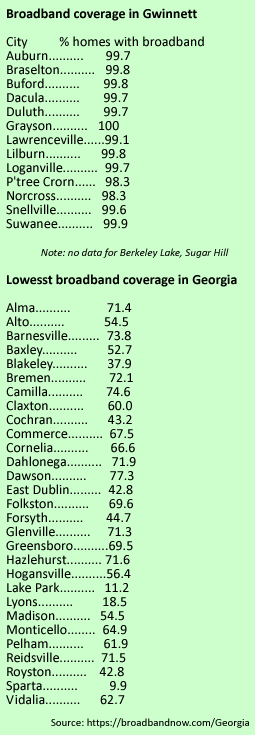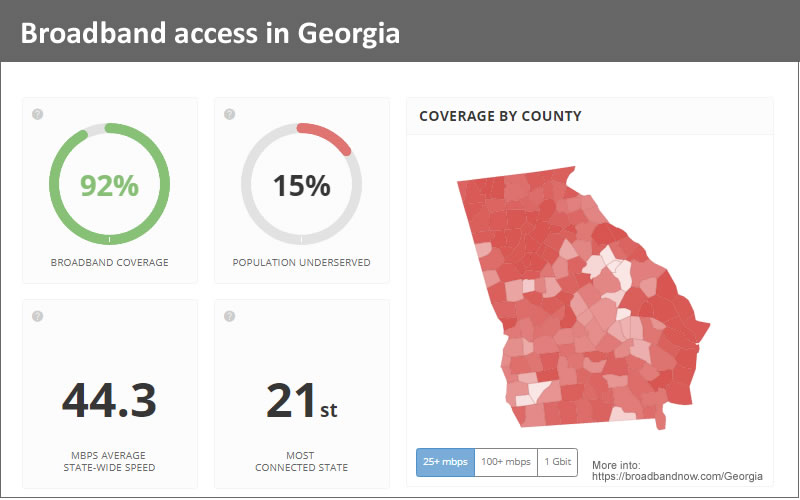By Elliott Brack
Editor and Publisher, GwinnettForum
JUNE 11, 2019 | Back in the 70s, Gov. Joe Frank Harris’ claiming that there were “two Georgias” astounded some for a while. Then people began realizing that indeed, Atlanta was different, and had far more opportunities, than communities in other parts of the state.
 Joe Frank’s idea was basically an economic one. Yet today we have a far greater problem for the rural areas of Georgia: broadband access. Many parts of rural Georgia do not have credible computer services, essentially denying people in these areas such items as:
Joe Frank’s idea was basically an economic one. Yet today we have a far greater problem for the rural areas of Georgia: broadband access. Many parts of rural Georgia do not have credible computer services, essentially denying people in these areas such items as:
- Students not being able to complete homework assignments online.
- Work-at-home entrepreneurs not being on a comparable level with other businesses.
- Health professionals in rural areas cannot send documents to other medical experts to study.
- Farmers cannot compete effectively with those who have internet access.
- Students in colleges in rural areas cannot gain the Internet with reliable speed to do research.
- And on and on.
 It is a vast limitation, largely unseen, but very present.
It is a vast limitation, largely unseen, but very present.
Note these two accompanying tables. One shows that we in Gwinnett cities have nearly complete access with a variety of multiple broadband suppliers. But also notice the table showing the cities in Georgia who have less than a 75 percent connection to multiple broadband service.
What does this mean?
In Georgia there are 693,000 individuals without access to a wired connection capable of 25 megabyte download speed. In many cities, you wait and wait for a slow connection, if you have one at all.
Another 1.3 million Georgians have access to only one wired provider of broadband. In most cases, that means that they pay far more for basic service, since they have no option to switch to a cheaper (and maybe faster) service.
Some 303,000 don’t have any wired Internet provider at all where they live.
This broadband service can be elusive. Take Dublin, Ga., a fairly progressive city, with 87.2 percent access to multiple broadband connectivity. Yet merely across the Oconee River, in East Dublin, also part of Laurens County, only 42.8 percent of homes have such a connection.
While this scenery is the case in Georgia, it’s similar across the nation, particularly in unbuilt-up areas of the West. It also has a built-in disparity on cost of internet service. In Zip Codes in the bottom 10 percent of population density, people pay 37 percent more on average for residential wired broadband than those in the top 10 percent. So this cannot only attack you in service, but in your pocketbook, too. It’s estimated that 146 million Americans do not have access to a low-price plan for residential broadband service.
These figures come from the web site, broadbandow.com, based on data from the Federal Communications Commission.
In Georgia, there is some hope, though it may come slowly. The Electric Membership Cooperatives (EMSs) are being given new opportunities by the Legislature to serve rural areas with broadband. However, in many EMC areas, a slow-to-move governing board may not appreciate the need for this additional service, holding back their areas. These EMC areas would have to get wired for this service, an additional cost.
There is also the possibility that low earth satellites in orbit could provide a comparable speed to wired connections. This would be faster and cheaper than wiring our country, and could ramp up within a couple of years. SPACE-x and Amazon are both working on this. They could be the hope for rural America in its future for broadband.
Rural Georgia can take a step away from the “two Georgias” with better broadband service.
- Have a comment? Send to: elliott@brack.net










Follow Us